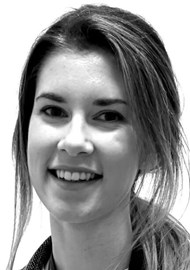Neuro-ophthalmology has always been a speciality of interest during my studies and now in my career. In 2018, I started a Band 7 post which gave me an extended role in neuro-ophthalmology and the responsibility of developing an orthoptic led neuro-ophthalmology service.
How can an orthoptist help?
Orthoptists diagnose and investigate ocular motility problems. Our eye movement findings can assist with general medical diagnoses and investigations. We also provide immediate help and advice to patients managing their ocular symptoms. There is strong support from NHS England and professional bodies that allied health professionals (AHP) – such as orthoptists – have a transformative potential within health and care. There is belief our contribution to specialist services can help the NHS provide high quality, accessible and timely care to an ever-increasing population.
Developing the role of an orthoptist is encouraged at Oxford Eye Hospital and within the trust. My orthoptic colleagues are involved in clinics such as: glaucoma, age-related macular degeneration, craniofacial, oculoplastics and paediatric neuro-oncology, to name a few. Integrated and multi-disciplinary working means services are less reliant on the availability of doctors. This in hand improves the ease and speed of access to specialist services.
Orthoptic input in neuro-ophthalmology is highly beneficial. We already have experience supporting the neuro-ophthalmology service with outpatient and inpatient appointments, ward rounds and neuro-rehabilitation centre assessments. When the opportunity arose for an orthoptic led position in neuro-ophthalmology I could not turn it down. I was motivated to develop further as a clinician by expanding my knowledge with an exciting new role.
Support and training
My training began with weekly observation sessions in outpatient clinics. Ms Sharma, the Consultant Neuro-ophthalmologist, and I developed a list of clinical competencies based on tests routinely performed during appointments. Within a few months the skills were signed off by Ms Sharma or one of her supporting doctors. To compliment my clinical exposure and private studying, I attended neuro-ophthalmology teaching sessions, neuro-orthoptic and brain tumour study days and radiology case presentations. In 2019 I completed a level 7 post-graduate qualification: ‘Specialist and Extended Roles in Neuro-ophthalmology’ with the University of Liverpool.
My clinical contribution
Gradually, I was developing a skillset to fully assess neuro-ophthalmic patients. A baseline examination for all patients requires a history, pupil exam, motility, lid and cranial nerve V and VI and slit-lamp assessment. Ms Sharma and I devised a list of cases suitable for an AHP to assess, this includes diagnoses such as: idiopathic intracranial hypertension (IIH), brain tumours, neurofibromatosis 1, multiple sclerosis, optic neuritis and Parkinson’s. Patients were soon referred to me and a list of five patients are booked per clinical session. At the end of each patient assessment, I discuss the findings with Ms Sharma and together we discuss further investigation and patient management.
Aside from gaining valuable patient experience, I have been fortunate enough to expand my responsibilities in other areas. Oxford is a regional centre for neuro-myelitis optica and an outpatient clinic runs weekly. I perform routine visual function tests and ensure smooth co-ordination of the clinic within the eye hospital. I have also been involved in departmental audit. During my clinical sessions I became increasingly involved with IIH patients and began to notice areas for improvement. In order to validate our current practice, I retrospectively audited our IIH service over a three-month period, comparing our service with national guidelines. It became apparent our patients’ pathways did not always meet those recommended. After writing up the results I designed a clinic proforma specifically for IIH consultations. Our patients now receive standardised follow-up periods and their body mass index (BMI) is recorded at every visit.
COVID-19 adaptions
As with many hospital out-patient services, neuro-ophthalmology implemented a telemedicine clinic in response to the COVID-19 pandemic. Face-to-face appointments were kept for new patients and those with worsening symptoms. In order to reduce patient numbers and the length of appointment time, patients were booked a telemedicine or ‘virtual’ clinic. Virtual clinics comprised of visual function tests, optical coherence tomography (OCT) imaging and visual fields if required. The test results are reviewed retrospectively and the patient is phoned to discuss the results, their symptoms and decide on a management plan. Recently we have begun booking more patients into face-to-face appointments but having discovered virtual clinics are appropriate for many of our patients, they will maintain a permanent feature. My role changed quite considerably due to the addition of virtual clinics, although they may have halted my practical experience, I became more competent interpreting tests and formulating management plans with less input from the doctors. I developed a rewarding sense of continuity phoning the same patients regularly and much to the team’s delight virtual clinics were well received by patients.
What next?
Clinics are gradually being booked to full capacity and there is scope for me to have a list of face-to-face patients again. I would like to maintain an element of virtual work so my weekly sessions will alternate between virtual and face-to-face appointments. Furthermore, an extended role in neuro-ophthalmology has given me insight into working within ophthalmology. While continuing my contribution to neuro-ophthalmology, I have enrolled in a part-time postgraduate course specialising in general ophthalmic conditions. I am motivated to enhance my current practice and progress as a clinician.
COMMENTS ARE WELCOME





